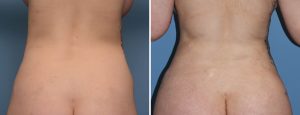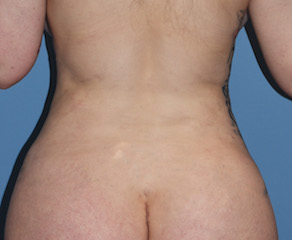
Having performed rib removal in over forty two (42) patients with over 200 ribs removed, I can provide the following observations on clinical outcomes.
Some patients remove ribs #11 and 12 only, the true free floaters, which is adequate if one has a longer waistline. A more aggressive or complete approach is to also include rib #10, which wraps around the waistline to attach to the subcostal rib cage. This is appropriate for those patients who have a shorter torso or want to do the ‘maximum’ effort. When removing ribs #10, 11 and 12 it is critical that the incision is placed over the posterolateral aspect of rib #11. Small skin incisions (5 cms) permit access to only one rib above or below the incision level.
- I have not seen any fluid-based issues including infections, hematomas, or serums. A small drain is often used for the first night after surgery.
- There is no risk of organ damage either intraoperatively or postoperatively. With ribs #11 and 12 overly the fascia of the kidney and rib #10 is close to the pleura of the lung, staying in the circumferential subperiosteal plane of the rib keeps the dissection away from these areas.
The amount of waistline reduction, as reported by patients, averages between 1 to 3 inches, depending on their body shape, weight, thickness of tissues and postoperative therapies. (e.g., corseting) I don’t get the opportunity to actually see most of the patients for long-term followup unless they come back for other surgeries. So good photographic documentation of the long-term results is limited.
- Patients report no long-term pain or any functional limitations once fully healed.
My clinical experience in rib removal surgery for waistline reduction is that it is perfectly safe and has no long term issues with partial loss of the outer portions of the lower ribs. In the properly selected patient it offers an amount of waistline reduction that can no otherwise be achieved.
Dr. Barry Eppley
Indianapolis, Indiana




 Some patients remove ribs #11 and 12 only, the true free floaters, which is adequate if one has a longer waistline. A more aggressive or complete approach is to also include rib #10, which wraps around the waistline to attach to the subcostal rib cage. This is appropriate for those patients who have a shorter torso or want to do the ‘maximum’ effort. When removing ribs #10, 11 and 12 it is critical that the incision is placed over the posterolateral aspect of rib #11. Small skin incisions (5 cms) permit access to only one rib above or below the incision level.
Some patients remove ribs #11 and 12 only, the true free floaters, which is adequate if one has a longer waistline. A more aggressive or complete approach is to also include rib #10, which wraps around the waistline to attach to the subcostal rib cage. This is appropriate for those patients who have a shorter torso or want to do the ‘maximum’ effort. When removing ribs #10, 11 and 12 it is critical that the incision is placed over the posterolateral aspect of rib #11. Small skin incisions (5 cms) permit access to only one rib above or below the incision level. The amount of waistline reduction, as reported by patients, averages between 1 to 3 inches, depending on their body shape, weight, thickness of tissues and postoperative therapies. (e.g., corseting) I don’t get the opportunity to actually see most of the patients for long-term followup unless they come back for other surgeries. So good photographic documentation of the long-term results is limited.
The amount of waistline reduction, as reported by patients, averages between 1 to 3 inches, depending on their body shape, weight, thickness of tissues and postoperative therapies. (e.g., corseting) I don’t get the opportunity to actually see most of the patients for long-term followup unless they come back for other surgeries. So good photographic documentation of the long-term results is limited.